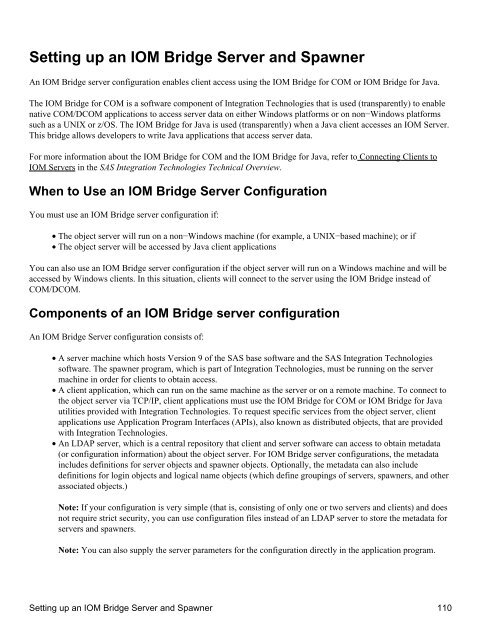SAS® Integration Technologies: Administrator's Guide (LDAP Version)
SAS® Integration Technologies: Administrator's Guide (LDAP Version)
SAS® Integration Technologies: Administrator's Guide (LDAP Version)
You also want an ePaper? Increase the reach of your titles
YUMPU automatically turns print PDFs into web optimized ePapers that Google loves.
Setting up an IOM Bridge Server and Spawner<br />
An IOM Bridge server configuration enables client access using the IOM Bridge for COM or IOM Bridge for Java.<br />
The IOM Bridge for COM is a software component of <strong>Integration</strong> <strong>Technologies</strong> that is used (transparently) to enable<br />
native COM/DCOM applications to access server data on either Windows platforms or on non−Windows platforms<br />
such as a UNIX or z/OS. The IOM Bridge for Java is used (transparently) when a Java client accesses an IOM Server.<br />
This bridge allows developers to write Java applications that access server data.<br />
For more information about the IOM Bridge for COM and the IOM Bridge for Java, refer to Connecting Clients to<br />
IOM Servers in the SAS <strong>Integration</strong> <strong>Technologies</strong> Technical Overview.<br />
When to Use an IOM Bridge Server Configuration<br />
You must use an IOM Bridge server configuration if:<br />
• The object server will run on a non−Windows machine (for example, a UNIX−based machine); or if<br />
• The object server will be accessed by Java client applications<br />
You can also use an IOM Bridge server configuration if the object server will run on a Windows machine and will be<br />
accessed by Windows clients. In this situation, clients will connect to the server using the IOM Bridge instead of<br />
COM/DCOM.<br />
Components of an IOM Bridge server configuration<br />
An IOM Bridge Server configuration consists of:<br />
• A server machine which hosts <strong>Version</strong> 9 of the SAS base software and the SAS <strong>Integration</strong> <strong>Technologies</strong><br />
software. The spawner program, which is part of <strong>Integration</strong> <strong>Technologies</strong>, must be running on the server<br />
machine in order for clients to obtain access.<br />
• A client application, which can run on the same machine as the server or on a remote machine. To connect to<br />
the object server via TCP/IP, client applications must use the IOM Bridge for COM or IOM Bridge for Java<br />
utilities provided with <strong>Integration</strong> <strong>Technologies</strong>. To request specific services from the object server, client<br />
applications use Application Program Interfaces (APIs), also known as distributed objects, that are provided<br />
with <strong>Integration</strong> <strong>Technologies</strong>.<br />
• An <strong>LDAP</strong> server, which is a central repository that client and server software can access to obtain metadata<br />
(or configuration information) about the object server. For IOM Bridge server configurations, the metadata<br />
includes definitions for server objects and spawner objects. Optionally, the metadata can also include<br />
definitions for login objects and logical name objects (which define groupings of servers, spawners, and other<br />
associated objects.)<br />
Note: If your configuration is very simple (that is, consisting of only one or two servers and clients) and does<br />
not require strict security, you can use configuration files instead of an <strong>LDAP</strong> server to store the metadata for<br />
servers and spawners.<br />
Note: You can also supply the server parameters for the configuration directly in the application program.<br />
Setting up an IOM Bridge Server and Spawner 110
















